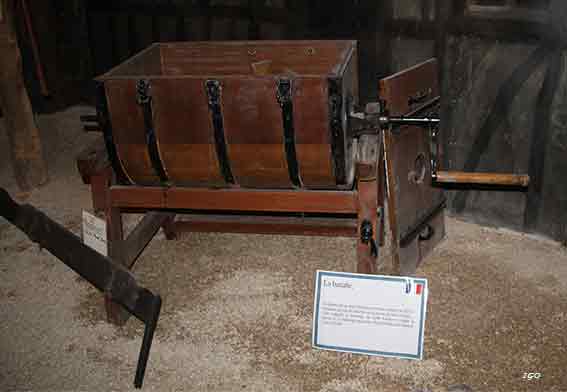Home > Heritage > Traditions
Traditions and practices
Traditions represent all these customs handed down from generation to generation. Some of them are recent; others are older and inherited from the Romans.
![]()
- Candlemas
- Christmas crib
- Christmas song
- Churning
- Mother's Day
- Sugared-almond
Butter making by churning
The traditional barrel-shaped churn was a frequent pattern on the farms of Picardy and was still relevant at the beginning of the 20th century. It made it possible to transform milk cream into butter after many turns of the crank.
Making butter was a bit technical with the churning. It was to isolate the fat particles from the liquid, buttermilk. The butter had to be washed, kneaded, and divided.
The dimensions of the churn could vary between the small model and the larger one, with a suitable mechanism to operate it. The medium-sized model, shown in the photo below, is displayed at the Museum of Former Jobs in Naours.

Churn is exhibited at the Museum of the Ancient Trades of Naours village.
Candlemas
This celebration takes place 40 days after Christmas, on February 2, for the presentation of Christ in the temple. This festival, known among the Romans as Candlemas, was tied to candles. An older belief finds its origin in the solar wheel.
Each region has specific recipes and local names, more commonly used in the past, such as crepets, cruspets, vales, tantimoles, and landimolle for Northern France.
For Vignacourt, the "Ratons" were popular until the 1950s. Abel Théot was the itinerant seller in Vignacourt for these pancakes during the First World War. It looked like pancakes but was more fluffy because it was made with yeast. This version is less prepared nowadays, replaced by lighter crepes.
The sale of "dariolles" and "ratons" already existed in the 16th century in France. Alcofribas Nasier, called Rabelais, appreciated this kind of pastry, especially those made from Amiens.

Street vendor of "dariolles and ratons," former traditional pastries
Engraving of Pierre Brebiette from the 17th century « Source gallica.bnf.fr/BnF »
Christmas crib
The first Christmas crib dates back to the 13th century, with a living representation of the nativity scene in the churches. The Christmas crib, with figurines, had been created several years later. The crib was introduced into homes in the 17th century by wealthy families, especially in Italy.
The child Jesus is shown in the barn, lying on the hay bed between the ox and the donkey. Balthazar carries gold, Melchior myrrh, and Gaspard incense.

Christmas song
Still Nacht is the German title of the song Silent Night, written by Joseph Mohr, and the music was composed by Franz Grüber after the Napoleonic War. This song was first played in 1818 in Oberndorf, Austria, and was heard on the battlefields in 1914 during the Christmas truce.
Since 2011, it has been part of world heritage, and it has been translated into many languages and reinterpreted many times around the world.
Mother's Day
The date of Mother's Day is the last Sunday of May in France. (sometimes early June due to Pentecost).
For the first time, a ceremony in honor of the mothers who had lost their sons was organized in the village of Artas near Lyon on June 10, 1906, on the initiative of M. Proser Roche, a teacher.
On June 16, 1918, the city of Lyon organized a ceremony for mothers who lost their sons during the war. This holiday then spread throughout France. This day was permanently fixed in the calendar in 1950.
On this occasion, young pupils draw, write poems on cards, craft small gifts, and offer flowers to their mothers.
Sugared-almond
The tradition of offering sugared almonds during baptisms dates back to ancient times. Julius Dragatus, a clumsy Roman, is said to have dropped an almond into honey. He was a confectioner by trade, and he offered some to his loved ones for the birth of his son.
The improved version of the almond sugar coating was invented by a Verdun apothecary in 1220 to find a way to preserve these almonds.
The tradition has lasted for centuries, and now there are a variety of dragees thanks to the inventiveness of confectioners.
